A Gas Cylinder Valve and Pressure Regulator
A Gas Cylinder Valve and Pressure Regulator
A gas cylinder is a pressure vessel used to store gases at above atmospheric pressure. Most medical gas cylinders (tanks) are constructed of steel, with various alloys added. Cylinders made from aluminum are available. Cylinders have flat or concave bases the other end may taper in to the neck that is fitted with tapered screw threads that attach to the valve.
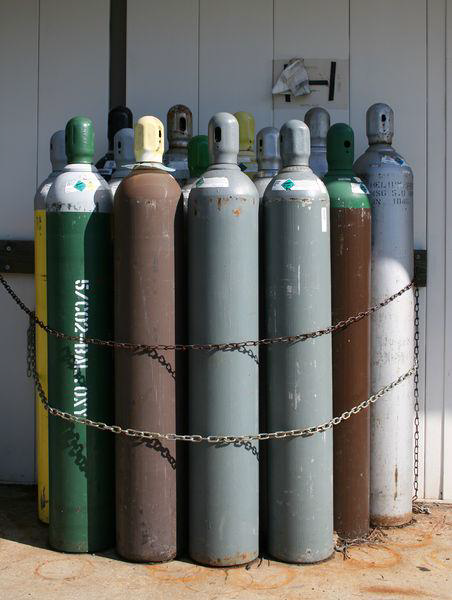
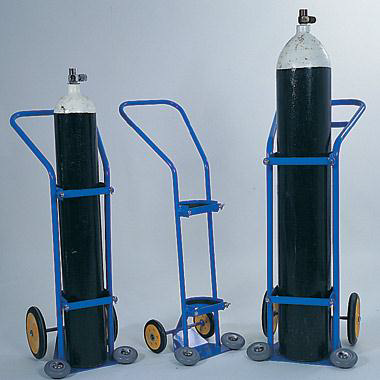
Size
A gas cylinder has different sizes from A- J. Medical gases are most commonly stored in "H" or "K" cylinders whose inside dimensions are 8 1/2" by 51". The water container capacity is approximately 1.54 cubic feet. Oxygen, nitrous oxide, and nitrogen are commonly stored in these cylinders. A hand truck must be used to transport "H" and "K" type cylinders from one location to another. Some facilities may use the smaller and more portable "E" type cylinders whose dimensions are 3 3/8" x 26". The water container capacity of "E" type cylinders is approximately 0.238 cubic feet. Typically, the "E" cylinders are used to supply gas to a single location. For example, portable cylinders that supply breathing apparatus may be temporarily installed on stretchers and wheelchairs used to transport patients from one part of the hospital to the other. "E" cylinders may also be positioned next to patient beds when required.
Portable cylinders attached to emergency medical equipment may be positioned in strategic locations throughout the hospital. For example, the cylinders may be attached to the crash cart positioned in the emergency room.
Valve
Cylinders are filled and discharged through a valve (spindle valve) attached to the neck. The valve (Figure 1.3), which is made of bronze or brass, is an integral part of the cylinder and should be removed only by the cylinder owner. The port is the point of exit for the gas. It should be protected in transit by a covering. Each valve contains stem, or a shaft, that is rotated during valve opening or closing. To close the valve, the stem seals against the seat that is part of the valve body.
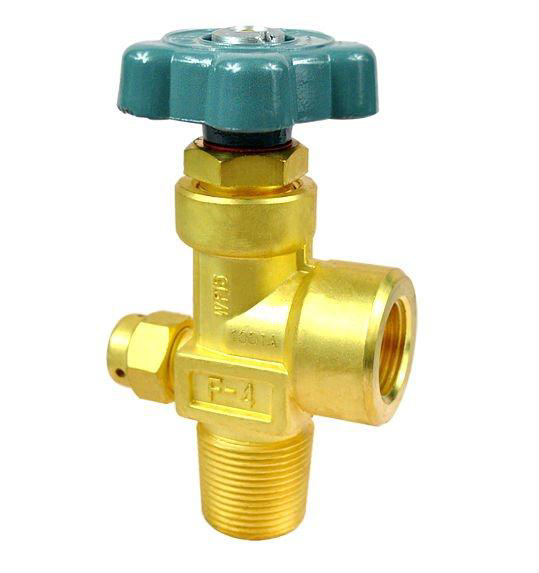
Pressure Regulator
Compressed gas may be used only when an approved pressure regulation device is installed to control the gas flow from the cylinder (figure 1.4). The certificate of fitness holder is responsible for making sure that compressed gas is never used without a pressure regulation device. Typically, two types of regulation devices are used in health care facilities: the regulator and the flowmeter. The regulator has one gauge that measures the pressure of the gas in the cylinder and another gauge that registers the rate of gas withdrawal from the cylinder.
The Flowmeter Measures
The flowmeter measures the rate of gas flow from the cylinder (Figure 1.5 and 1.6). The gas flow through the flowmeter is controlled by turning the adjusting knob on the flowmeter. The certificate of fitness holder must know how to operate all pressure regulation devices used at his or her facility. Needle valves or similar devices without regulating mechanisms should not be used in place of pressure reducing regulators because excessive pressures may develop downstream of such devices and result in possible damage to equipment or injury to personnel.
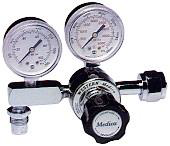
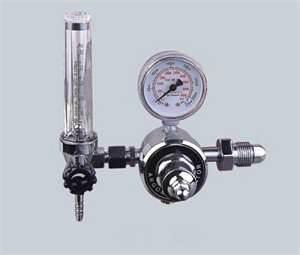

Threads and connections on the pressure regulation devices are designed such that they can only be used to control the discharge of a particular gas. For example, the threads or connections on an oxygen regulator will not fit the threads on a nitrous oxide cylinder. Regulators must not be modified or used where they were not intended to be used. Each regulator should be labeled in a manner that identifies the type of system where the regulator should be used.
Regulators, gauges (Figure 1.4 and 1.5), and valves used in health care facilities must be to industry standards prior to being placed into service. Contamination, such as oil or grease, may act as a fuel when mixed with some medical gases. For example, oil or grease particles can react with explosive violence when exposed to oxygen. The certificate of fitness holder must keep a supply of clean replacement regulators, gauges, and flowmeters available in case of emergency at the health care facility. Defective regulation devices must be replaced immediately and arrangements must be made to have them repaired by the supplier or the manufacturer.
Connecting Pressure Regulation Devices
The cylinder's valve must be blown clear before a pressure regulation device is installed. This is done by slowly cracking the valve for an instant to get rid of contaminants (such as dirt and dust). Only approved wrenches or tools, provided by the gas supplier, may be used when connecting a regulating device. Once the regulation device has been connected the cylinder valve, the gas must never be permitted to enter the regulating device suddenly because it may react violently with the contaminants in the system. This is especially important when the gas used is oxygen because it may react violently when it impacts with parts of the regulator.